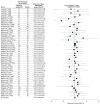Effect of Vitamin D Supplementation on Blood Pressure: A Systematic Review and Meta-analysis Incorporating Individual Patient Data
- PMID: 25775274
- PMCID: PMC5966296
- DOI: 10.1001/jamainternmed.2015.0237
Effect of Vitamin D Supplementation on Blood Pressure: A Systematic Review and Meta-analysis Incorporating Individual Patient Data
Erratum in
-
Correction to Meta-Analysis to Acknowledge Retracted Study.JAMA Intern Med. 2025 Mar 1;185(3):352-353. doi: 10.1001/jamainternmed.2025.0063. JAMA Intern Med. 2025. PMID: 39869363 Free PMC article. No abstract available.
Abstract
Importance: Low levels of vitamin D are associated with elevated blood pressure (BP) and future cardiovascular events. Whether vitamin D supplementation reduces BP and which patient characteristics predict a response remain unclear.
Objective: To systematically review whether supplementation with vitamin D or its analogues reduce BP.
Data sources: We searched MEDLINE, CINAHL, EMBASE, Cochrane Central Register of Controlled Trials, and http://www.ClinicalTrials.com augmented by a hand search of references from the included articles and previous reviews. Google was searched for gray literature (ie, material not published in recognized scientific journals). No language restrictions were applied. The search period spanned January 1, 1966, through March 31, 2014.
Study selection: We included randomized placebo-controlled clinical trials that used vitamin D supplementation for a minimum of 4 weeks for any indication and reported BP data. Studies were included if they used active or inactive forms of vitamin D or vitamin D analogues. Cointerventions were permitted if identical in all treatment arms.
Data extraction and synthesis: We extracted data on baseline demographics, 25-hydroxyvitamin D levels, systolic and diastolic BP (SBP and DBP), and change in BP from baseline to the final follow-up. Individual patient data on age, sex, medication use, diabetes mellitus, baseline and follow-up BP, and 25-hydroxyvitamin D levels were requested from the authors of the included studies. For trial-level data, between-group differences in BP change were combined in a random-effects model. For individual patient data, between-group differences in BP at the final follow up, adjusted for baseline BP, were calculated before combining in a random-effects model.
Main outcomes and measures: Difference in SBP and DBP measured in an office setting.
Results: We included 46 trials (4541 participants) in the trial-level meta-analysis. Individual patient data were obtained for 27 trials (3092 participants). At the trial level, no effect of vitamin D supplementation was seen on SBP (effect size, 0.0 [95% CI, -0.8 to 0.8] mm Hg; P=.97; I2=21%) or DBP (effect size, -0.1 [95% CI, -0.6 to 0.5] mm Hg; P=.84; I2=20%). Similar results were found analyzing individual patient data for SBP (effect size, -0.5 [95% CI, -1.3 to 0.4] mm Hg; P=.27; I2=0%) and DBP (effect size, 0.2 [95% CI, -0.3 to 0.7] mm Hg; P=.38; I2=0%). Subgroup analysis did not reveal any baseline factor predictive of a better response to therapy.
Conclusions and relevance: Vitamin D supplementation is ineffective as an agent for lowering BP and thus should not be used as an antihypertensive agent.
Conflict of interest statement
Figures



References
-
- Scragg R, Sowers M, Bell C. Serum 25-hydroxyvitamin D, ethnicity, and blood pressure in the Third National Health and Nutrition Examination Survey. Am J Hypertens. 2007;20(7):713-719. - PubMed
-
- Kunutsor SK, Apekey TA, Steur M. Vitamin D and risk of future hypertension: meta-analysis of 283 537 participants. Eur J Epidemiol. 2013;28(3):205-221. - PubMed
-
- Norman AW. From vitamin D to hormone D: fundamentals of the vitamin D endocrine system essential for good health. Am J Clin Nutr. 2008;88(2):491S-499S. - PubMed
-
- Sugden JA, Davies JI, Witham MD, Morris AD, Struthers AD. Vitamin D improves endothelial function in patients with type 2 diabetes mellitus and low vitamin D levels. Diabet Med. 2008;25(3):320-325. - PubMed
Publication types
MeSH terms
Substances
Grants and funding
LinkOut - more resources
Full Text Sources
Other Literature Sources
Medical

